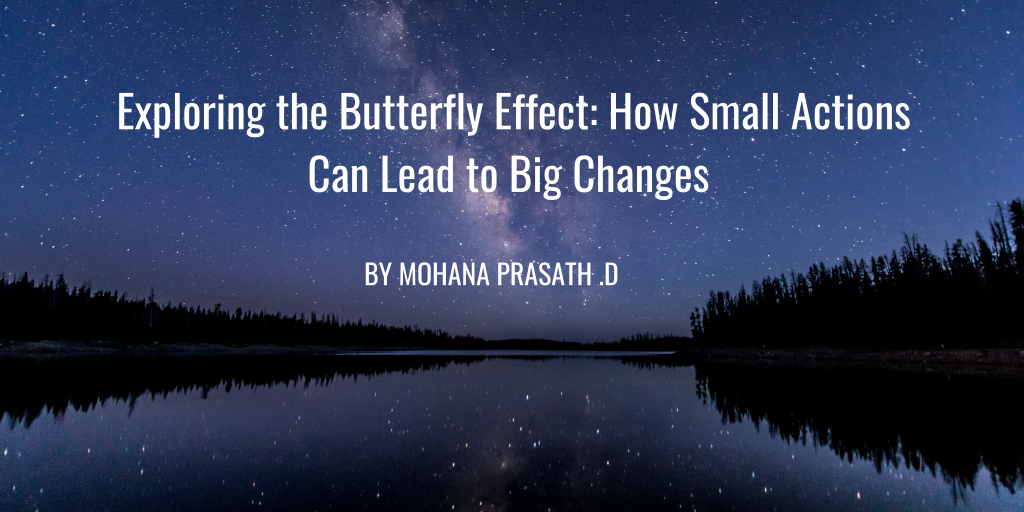BY MOHANA PRASATH .D
Have you ever stopped to consider the profound impact that small actions can have on the world around us? This phenomenon is known as the butterfly effect, a concept that originated in chaos theory and has captured the imagination of scientists, philosophers, and thinkers alike.
What is the Butterfly Effect?
The butterfly effect is a metaphorical concept that suggests small changes in one part of a complex system can lead to significant and unpredictable outcomes in another part of the system. The term was coined by mathematician and meteorologist Edward Lorenz, who proposed that the flap of a butterfly’s wings in Brazil could set off a tornado in Texas.
“We are all connected, and our actions have the power to shape the course of history, one tiny flutter at a time.”
Understanding Chaos Theory
At the heart of the butterfly effect lies chaos theory, a branch of mathematics and science that studies the behavior of dynamic systems that are highly sensitive to initial conditions. Chaos theory reveals that even seemingly minor variations in the starting conditions of a system can lead to vastly different outcomes over time.

Examples of the Butterfly Effect
The butterfly effect can be observed in various aspects of our lives, from weather patterns to financial markets to social dynamics. For example, a small decision made by an individual can have far-reaching consequences for their own life trajectory and the lives of those around them. Similarly, a seemingly insignificant event in one part of the world can trigger a chain reaction of events with global implications.
“The butterfly effect teaches us that we are not powerless in the face of chaos; our choices matter, and even the smallest of gestures can change the world.”
Implications and Applications
Understanding the butterfly effect has profound implications for how we perceive and interact with the world. It highlights the interconnectedness of all things and emphasizes the importance of considering the long-term consequences of our actions. Moreover, it underscores the limitations of prediction and control in complex systems, reminding us of the inherent uncertainty and unpredictability of life.
Several theories and concepts correlated with the butterfly effect
1. Chaos Theory: The butterfly effect is a key concept within chaos theory, which studies the behavior of dynamic systems that are highly sensitive to initial conditions. Chaos theory explores how seemingly random and unpredictable behavior can emerge from deterministic systems.
2. Complex Systems Theory: Complex systems theory examines how interactions between individual components of a system give rise to emergent behavior at the system level. The butterfly effect illustrates the non-linear relationships and feedback loops present in complex systems.
3. Sensitive Dependence on Initial Conditions: This principle, closely related to chaos theory, asserts that small differences in initial conditions can lead to vastly different outcomes over time. The butterfly effect exemplifies the sensitive dependence of complex systems on their starting states.
“We may not realize the impact of our actions, but every choice we make has a ripple effect, shaping the world in ways we cannot foresee.”
4. Nonlinear Dynamics: Nonlinear dynamics investigates the behavior of systems whose outputs are not directly proportional to their inputs. The butterfly effect highlights the nonlinear relationships and amplification of small changes that occur in complex systems.
5. Fractal Geometry: Fractal geometry is a branch of mathematics that studies irregular shapes or patterns that repeat at different scales. The butterfly effect can be visualized through fractal patterns, demonstrating how small structures are replicated at larger scales within chaotic systems.
These theories and concepts provide frameworks for understanding the underlying principles behind the butterfly effect and its implications for complex systems and dynamic phenomena.
“The butterfly effect reminds us that the world is interconnected and that even the smallest actions can have profound consequences.”
Conclusion
In a world that often feels chaotic and uncertain, the butterfly effect offers both a warning and a promise. It reminds us of the power of small actions to shape the course of history and the importance of humility in the face of complexity. By embracing the butterfly effect, we can cultivate a deeper appreciation for the interconnectedness of all things and strive to make positive changes, one flap of a wing at a time.
For a deeper dive, check out these video links
THANK YOU.
Location on the cover: Oregon, United States of America
CONTENT BY MOHANA PRASATH .D
FORMATTING BY JANANI SRIRAMAN
From IT-B.



Leave a comment